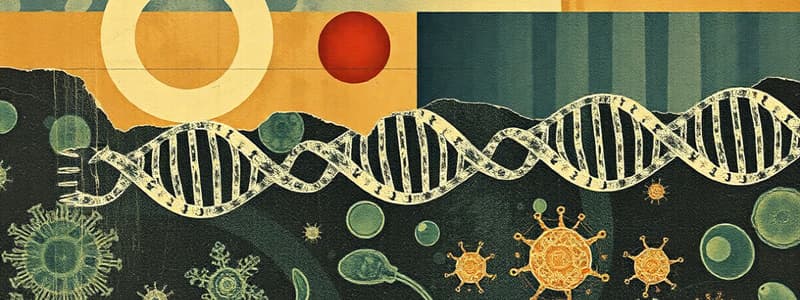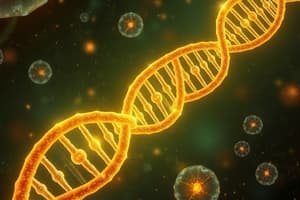Podcast
Questions and Answers
What is the approximate total length of DNA in a single human cell?
What is the approximate total length of DNA in a single human cell?
- 2 meters (correct)
- 1 meter
- 4 meters
- 3 meters
What is a key requirement for DNA despite its length?
What is a key requirement for DNA despite its length?
- It must be able to replicate easily.
- It must be contained within cells. (correct)
- It must be accessible by all cellular components.
- It must be exposed to the environment.
Why is the containment of DNA within cells significant?
Why is the containment of DNA within cells significant?
- It allows for protein synthesis.
- It protects DNA from environmental damage. (correct)
- It enables easy access for transcription.
- It prevents DNA from degrading.
What challenges does the length of DNA in cells present?
What challenges does the length of DNA in cells present?
How does the length of DNA compare to the size of human cells?
How does the length of DNA compare to the size of human cells?
What is the approximate total length of DNA in human cells, emphasizing its containment?
What is the approximate total length of DNA in human cells, emphasizing its containment?
Why must DNA in human cells be contained within a confined space?
Why must DNA in human cells be contained within a confined space?
What size challenge is presented by the length of cellular DNA in a human cell?
What size challenge is presented by the length of cellular DNA in a human cell?
What is a possible consequence of not properly containing the lengthy DNA in cells?
What is a possible consequence of not properly containing the lengthy DNA in cells?
Which of the following statements about the length of DNA in human cells is true?
Which of the following statements about the length of DNA in human cells is true?
What is the approximate length of DNA in a single human cell?
What is the approximate length of DNA in a single human cell?
What is a key reason for the containment of DNA within cells?
What is a key reason for the containment of DNA within cells?
How is the total length of cellular DNA in a human cell characterized relative to the cell's diameter?
How is the total length of cellular DNA in a human cell characterized relative to the cell's diameter?
Which of the following reflects a challenge regarding DNA length in human cells?
Which of the following reflects a challenge regarding DNA length in human cells?
Why is it important for the DNA to be contained within a confined space in human cells?
Why is it important for the DNA to be contained within a confined space in human cells?
Flashcards are hidden until you start studying
Study Notes
DNA in a Human Cell
- The total length of DNA in one human cell is approximately 2 meters
- DNA must be packaged tightly within the cell’s nucleus
- The containment of DNA within cells protects the genetic information from damage and ensures that it is passed on to daughter cells during cell division.
- The extreme length of DNA presents a challenge for packaging and organizing it within the cell
- The length of DNA is significantly larger than the size of a human cell.
DNA Length within a Cell
- The total length of DNA within a single human cell is approximately 2 meters.
- A key requirement for DNA, despite its length, is that it must be tightly packaged and contained within the cell's nucleus.
- The containment of DNA within cells is significant because it ensures that the genetic material is organized and protected from damage.
- The length of DNA presents challenges for containment, as it needs to be compacted into a much smaller space.
- Human cells are microscopic, on the order of micrometers in size.
- This means that approximately 2 meters of DNA are packed into a space that is only about 10 to 100 micrometers in diameter.
- DNA must be contained in a confined space to prevent tangling, breakage, and damage.
- The challenge is the sheer length of the DNA compared to the size of the cell, necessitating sophisticated mechanisms for compacting the genome.
- Not properly containing DNA within the cell can lead to problems with replication, transcription, and cell division.
- The statement that is true about the length of DNA in human cells is that it's much longer than the cell itself, requiring sophisticated packaging mechanisms.
DNA Length and Confinement
- The total length of DNA in a single human cell is approximately 2 meters (6.5 feet), which is about 100,000 times the diameter of a typical human cell.
- Despite its length, a key requirement for DNA is proper containment within the cell's nucleus.
- This containment is essential because it prevents DNA from becoming tangled and damaged, allowing for efficient replication and transcription.
- The enormous length of DNA presents significant challenges for its containment, as it must be tightly packaged and organized within the minute space of the cell's nucleus.
- The length of DNA is considerably greater than the size of human cells, posing a challenge for its proper organization and function within the confined space.
- The approximate total length of DNA in human cells, emphasizing its containment, is 2 meters (6.5 feet) within a cell with a diameter of about 10 micrometers.
- DNA in human cells must be contained within a confined space to ensure proper organization, prevent tangling and damage, and facilitate efficient replication and transcription.
- The cellular DNA length presents a size challenge because it is approximately 100,000 times greater than the diameter of a human cell.
- Not properly containing the lengthy DNA could lead to tangling, damage, and disruption of essential cellular processes.
- The true statement about the length of DNA in human cells is that it is significantly longer than the cell's diameter, necessitating its containment within the nucleus.
Studying That Suits You
Use AI to generate personalized quizzes and flashcards to suit your learning preferences.



